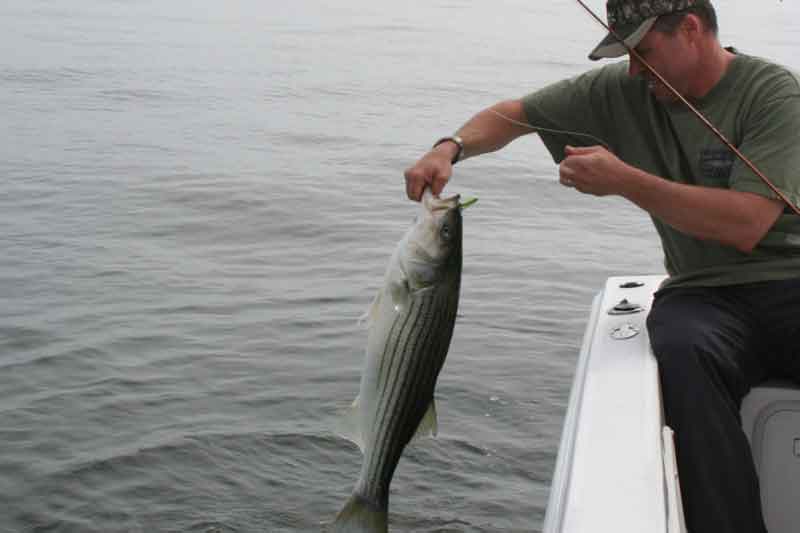We wait all winter for it — and spring on the Chesapeake offers some of the most diverse and challenging striped bass fishing opportunities available anywhere. It also offers the chance to catch a massive striper on fly or light tackle, if you know where to look and how to fish for them. The spring fishery changes every day, every tide even, so knowing some different techniques will make this time of year even more fun.

Everyone knows that you can catch nice fish in the spring by trolling everything but the kitchen sink along the channel edges. This works, but can get tedious. It also necessitates the use of heavy tackle which makes fighting these fish a little less sporting. Switching to light tackle and fly gear offers a way to catch fish and enjoy the experience a little more.
One has to be careful of which rivers are open to catch and release fishing and on what dates. For instance, the Choptank doesn’t allow catch and release until later in the spring while Eastern Bay is open all spring—at least that was still true when this article was written (due to the constantly changing regs, we advise visiting the DNR website before your next trip). It’s important to note this because most of my fishing takes place in the rivers and smaller bays, and not in the main channel. Trying to target fish in the main channel or channel edges with light tackle is very difficult early in the year because fish are on the move and aren’t schooled up—it becomes a needle in a haystack situation.
On the other hand, fish in the rivers are going to congregate around points, drop-offs, and areas that are predictable and fishable. Where to start depends a lot on what sort of weather we’ve been having. Stripers and especially big stripers are going to be looking for water between 55 and 65 degrees. The shallows of a river, especially on the north side, are going to be the first places to warm. I like to start in the very shallowest areas, and if the water is clear enough and the bottom light enough in color, you could even have sight fishing opportunities. However, this is generally not the case and blind casting is required.
If the water is less than five feet deep, I’ll switch to a floating fly line or an unweighted soft plastic. This will avoid constant hang-ups and the associated aggravation. Chesapeake shorelines are snag-magnets, so avoiding this is crucial to success. Weighted flies are in order whether fishing floating or sinking lines, perhaps because they’re a better facsimile of the bait they are likely eating the rivers. I do have some big, honking herring patterns as well, in case I think there are really big fish around.
Most flies are going to be chartreuse or blue Clousers and half-and-halfs. EP flies and deceivers may also work, but not as often. When fishing unweighted soft plastics, a worm hook or more commonly a corkscrew-type worm hook works well. These help keep the baits weedless and are very sticky, so you don’t miss strikes. Your casting distance is impaired by these, however, so it’s not a bad idea to have some of the weighted cork screw style hooks on hand as well.
After hitting points and bights in the shallow sections I’ll drift off to where the river goes from five to 10 feet. The bathymetry of many tributary rivers is like this, with a shallow flat against the shoreline which warms up quickly, and then a drop off down to 10 feet or so. This ledge can be an ideal spot, and is a lot easier to fish since you’re not worrying about drifting into shore all the time. The tricky part with fishing this ledge? It likely has little structure in one place versus another, and there may be miles of it, so you’ll have to look around quite a bit. Search for underwater points and places where the channel turns as starting points, and just keep looking from there. Side-scan sonar helps, and again, be cognizant of water temperature as you move around.
On these ledges I fish the same flies as I do in the shallows but on a full sink line. An intermediate has little applicability as they sink too much for the shallow flats and not enough for the deeper areas, especially if there’s any wind. Number one to 2/0 Clousers and half-and-halfs are good bets here, as well. With light tackle, use the same six-inch soft plastics as used in the shallows, but rig them on half-ounce jig heads. You usually don’t need any more than that in 10 feet of water and you don’t want to use too much weight as it will impede the action. Remember, you want these baits moving slowly, especially if the water is cold—heavier jigs will have you hanging up.

Give these techniques a try this spring. You’ll be surprised how much fun it is, and at how big a fish you can catch without having to troll all day.
-By Michael Behot